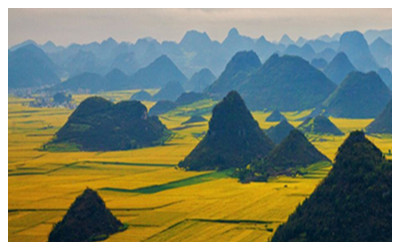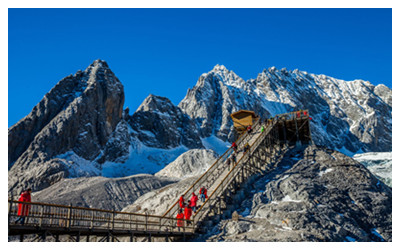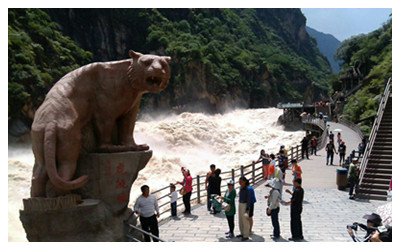Skype: neodalle-travel
Tel: +86 135 7447 2266
E-mail: sales@zhangjiajieholiday.com

Best Time to visit Yunnan
 The most salient feature of the weather of Yunnan Province is that the daily temperature (night to day temperature) varies more than does the seasonal temperature (winter to summer temperature). That said, the weather also varies greatly in Yunnan depending on which region, north or south, where one finds oneself (the lateral-spatial dimension), just as it of course varies greatly with the altitude (the vertical-spatial dimension). Regarding the former, the weather in Yunnan Province varies considerably depending on whether one finds oneself in in the mountainous north (a temperate zone) - especially in the northwest - in the south (a tropical zone) or in-between (a subtropical zone). The subtropical and tropical zones tend to be hot and humid, the more so in the tropical than in the subtropical zone. The Tropic of Capricorn lies in the province's tropical, southerly region.
The most salient feature of the weather of Yunnan Province is that the daily temperature (night to day temperature) varies more than does the seasonal temperature (winter to summer temperature). That said, the weather also varies greatly in Yunnan depending on which region, north or south, where one finds oneself (the lateral-spatial dimension), just as it of course varies greatly with the altitude (the vertical-spatial dimension). Regarding the former, the weather in Yunnan Province varies considerably depending on whether one finds oneself in in the mountainous north (a temperate zone) - especially in the northwest - in the south (a tropical zone) or in-between (a subtropical zone). The subtropical and tropical zones tend to be hot and humid, the more so in the tropical than in the subtropical zone. The Tropic of Capricorn lies in the province's tropical, southerly region.
The vertical-spatial dimension refers to altitude, such as that found in mountainous areas. The really curious thing here is that there are deep gorges alongside towering, snow-capped mountains where the former exhibit a subtropical climate while the latter exhibits a frigid zone at its top and a temperate zone near its base. The difference between the subtropical climate of the northern gorges and the subtropical climate of the plateau farther south (and of the tropical rain-forest even farther south, for that matter) is that the former is hot and arid while the latter is hot and humid.
 It is amazing to imagine that one can find snow-capped mountains, replete with a ski resort, at one end of the province and a tropical rain-forest, replete with wild Asian elephants (and the environmentally-threatened - and now protected - Yunnan Golden Monkey, as well as many other endangered species of animals and rare plants), at the other end of the province, but it is even more amazing to imagine that one can find a deep, subtropical gorge, replete with the flora and fauna that belongs to the subtropics, alongside the same snow-capped mountain where one has been skiing earlier in the day, yet this exists in Yunnan Province: the Jinsha River Basin, which comprises Tiger Leaping Gorge, one of the world's deepest gorges - if not THE deepest gorge - passes between Jade Dragon Snow Mountain and Haba Snow Mountain in the northwestern part of Yunnan Province.
It is amazing to imagine that one can find snow-capped mountains, replete with a ski resort, at one end of the province and a tropical rain-forest, replete with wild Asian elephants (and the environmentally-threatened - and now protected - Yunnan Golden Monkey, as well as many other endangered species of animals and rare plants), at the other end of the province, but it is even more amazing to imagine that one can find a deep, subtropical gorge, replete with the flora and fauna that belongs to the subtropics, alongside the same snow-capped mountain where one has been skiing earlier in the day, yet this exists in Yunnan Province: the Jinsha River Basin, which comprises Tiger Leaping Gorge, one of the world's deepest gorges - if not THE deepest gorge - passes between Jade Dragon Snow Mountain and Haba Snow Mountain in the northwestern part of Yunnan Province.
 The subtropical and tropical zones to the middle and south of the province are characterized by a humid, monsoon climate that is divided roughly between a wet (rainy) and a dry (non-rainy, but still humid) period. During the monsoon, or rainy, season, the daily rains can be torrential at times, but it seems to rain incessantly, with few respite periods. Duing the wet period, which is from May to October, 85% of the annual precipitation that falls in the region falls during this period. In the temperate zone to the north, the precipitation is more evenly distributed throughout the year, with a slight concentration of rain in the spring and fall, and the precipitation is more unevenly distributed throughout the area on any given rainy day or a day with occasional rain showers, just as one would expect to find in any temperate zone anywhere.
The subtropical and tropical zones to the middle and south of the province are characterized by a humid, monsoon climate that is divided roughly between a wet (rainy) and a dry (non-rainy, but still humid) period. During the monsoon, or rainy, season, the daily rains can be torrential at times, but it seems to rain incessantly, with few respite periods. Duing the wet period, which is from May to October, 85% of the annual precipitation that falls in the region falls during this period. In the temperate zone to the north, the precipitation is more evenly distributed throughout the year, with a slight concentration of rain in the spring and fall, and the precipitation is more unevenly distributed throughout the area on any given rainy day or a day with occasional rain showers, just as one would expect to find in any temperate zone anywhere.
As indicated, there are distinct vertical-spatial climatic zones on mountain slopes, ranging from a temperate to a frigid zone, where snow and ice accumulate permanently. The general rule of thumb is that the temperature decreases 0.5 degree Celsius on a mountain slope for every 100 meters of elevation, which calls for proper attire, something that is a challenge with such a spread in temperature. There is a local saying that sums up the weather in northern Yunnan Province: "You can enjoy all four seasons on the same mountain, where all four seasons can be traversed over a stretch of less than four kilometers."
The best time to visit the central and southern subtropical and tropical zones (and you wouldn't want to miss the wild elephant reserve at Xishuangbanna!) is just prior to the beginning of the wet season, or from April to June, when the sunshine is abundant, the rain infrequent and the humidity is not yet a factor to be concerned about. It is also a time of year when the area's flora unfolds before your very eyes. The temperate zone to the north can be visited any time, but you will probably wish to visit both areas on the same trip. If you are the hardy type, you can surely tolerate a day or two in Xishuangbanna even during the monsoon season - the monsoon rains are a unique experience in themselves.
Travel Tips for Yunnan Weather
The best time to travel in Yunnan is in spring and autumn, especially March to April, and September to November. In spring (March to May), Yunnan has the large daily temperature difference changing from 12 to 20 ℃. The month of May is likely to be the rainiest month. Summer (June to August) in Yunnan will not be very hot and winter in Yunnan is never too cold. Autumn is the harvest season of most fruits and flowers. Tourists can get a lot during their trips.
Clothes for travelling:
August in Yunnan is generally rainy season, you’d better wear thin coat. If you want to go to Jade Dragon Snow Mountain in Lijiang, you should take thicker cotton-padded clothes.
Go to Yunnan in March, travelers need to wear cotton jersey and a thicker coat, cotton trousers and over-trousers.
Lijiang has a large temperature difference between morning and evening, it is generally to put on your thick coat or eiderdown outerwear in the morning and evening.
Avoid Peak Holidays:
It is not a good idea to travel in China during Chinese holidays when huge numbers of Chinese people are travelling around. The busiest three national holidays in China are Chinese Spring Festival (usually in late Jan or early Feb.), International Labor Day (May 01 to 03) and National Day (Oct 01-07).. Spring Festival is an especially crowded time to travel. The advantage of being in China at this time is that you will get the opportunity to experience "first hand" the significance of these celebrations in Chinese culture.
Other Tips:
The sunshine in Yunnan is too strong during the day that you’d better take your sunscreen and sunglasses. Also you should drink more water, eat more fruit, and prevent dehydration.
In winter and spring, Kunming has large daily temperature difference, so travelers need to take coats and sweaters.
 Ask Questions ?
Ask Questions ?